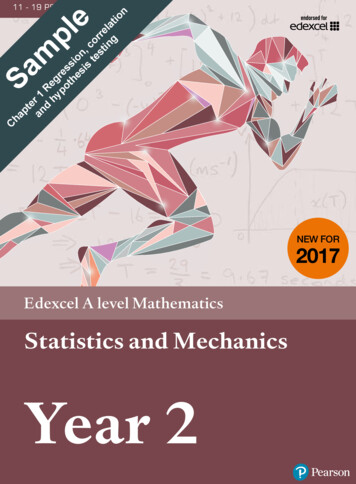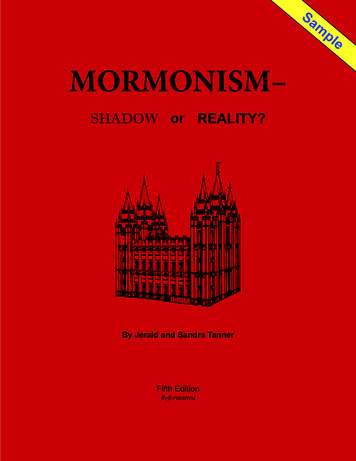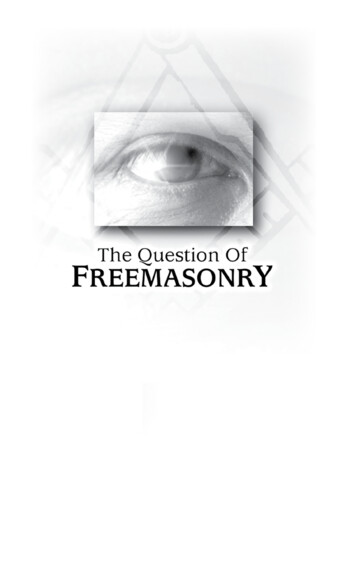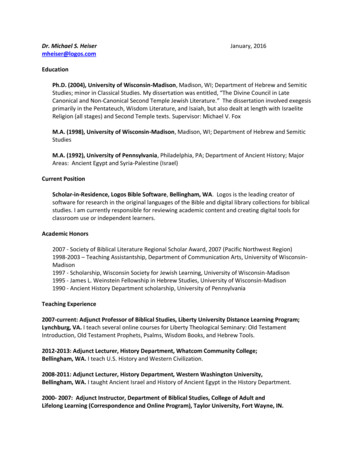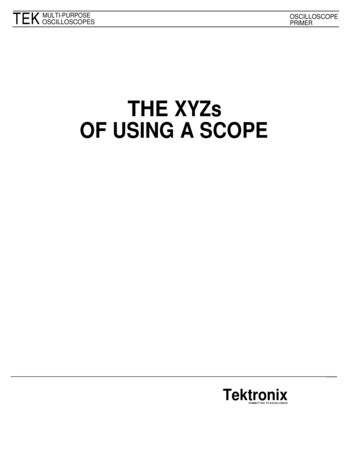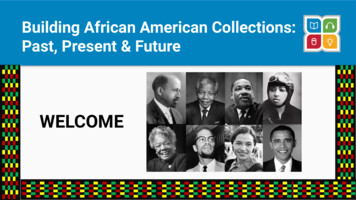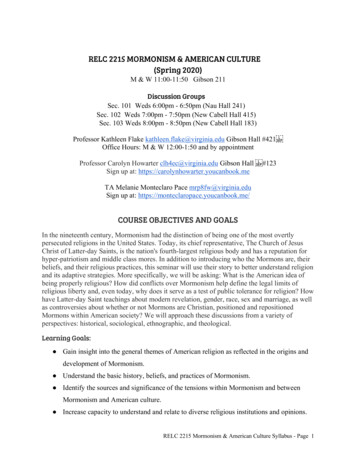
Transcription
RELC 2215 MORMONISM & AMERICAN CULTURE(Spring 2020)M & W 11:00-11:50 Gibson 211Discussion GroupsSec. 101 Weds 6:00pm - 6:50pm (Nau Hall 241)Sec. 102 Weds 7:00pm - 7:50pm (New Cabell Hall 415)Sec. 103 Weds 8:00pm - 8:50pm (New Cabell Hall 183)Professor Kathleen Flake kathleen.flake@virginia.edu Gibson Hall #421Office Hours: M & W 12:00-1:50 and by appointmentProfessor Carolyn Howarter clh4ec@virginia.edu Gibson HallSign up at: https://carolynhowarter.youcanbook.me#123TA Melanie Monteclaro Pace mrp8fw@virginia.eduSign up at: https://monteclaropace.youcanbook.me/COURSE OBJECTIVES AND GOALSIn the nineteenth century, Mormonism had the distinction of being one of the most overtlypersecuted religions in the United States. Today, its chief representative, The Church of JesusChrist of Latter-day Saints, is the nation's fourth-largest religious body and has a reputation forhyper-patriotism and middle class mores. In addition to introducing who the Mormons are, theirbeliefs, and their religious practices, this seminar will use their story to better understand religionand its adaptive strategies. More specifically, we will be asking: What is the American idea ofbeing properly religious? How did conflicts over Mormonism help define the legal limits ofreligious liberty and, even today, why does it serve as a test of public tolerance for religion? Howhave Latter-day Saint teachings about modern revelation, gender, race, sex and marriage, as wellas controversies about whether or not Mormons are Christian, positioned and repositionedMormons within American society? We will approach these discussions from a variety ofperspectives: historical, sociological, ethnographic, and theological.Learning Goals: Gain insight into the general themes of American religion as reflected in the origins anddevelopment of Mormonism. Understand the basic history, beliefs, and practices of Mormonism. Identify the sources and significance of the tensions within Mormonism and betweenMormonism and American culture. Increase capacity to understand and relate to diverse religious institutions and opinions.RELC 2215 Mormonism & American Culture Syllabus - Page 1
REQUIRED TEXTSMason, Patrick. What is Mormonism? (Routledge, 2017) [Digital version available on Virgo]All other readings are filed under “Resources” on UVA Collab at http://collab.itc.virginia.edu orhyperlink on the syllabus.In addition, MormonWiki and The Encyclopedia of Mormonism contain short articles written byMormon and non-Mormon scholars on every topic treated in this course. If you have questions asyou go along or if you want more suggestions for reading on any given topic, these sites canhelp.Official information about The Church of Jesus Christ of Latter-day Saints is available at threesites designed for three audiences: https://www.churchofjesuschrist.org/?lang eng for orld for non-members, andhttps://newsroom.churchofjesuschrist.org for media outlets.This most populous representation of the Mormon movement will be the focus of our studies.Reference will be made, however, to other churches which trace their origins to Joseph Smith,such as the Community of Christ.ASSIGNMENTS AND GRADES20% Forums 35% Exams 5% Pop Quizzes 40% Participation20% FORUMSFor each Wednesday we have lecture, please post a comment in the Collab Forum thatdemonstrates you have read and thought about the class readings for that week. Please alsorespond to one classmate's comment (unless you are the first to post). You may use the "ReadingCue" as a starting point, but please quickly turn to your own questions and observations.Your comment should be posted no later than Wednesday at 10:00AM, and should be no longerthan five sentences. LATE POSTINGS WILL NOT BE GRADED. Your lowest forum postgrade will be dropped.Each week's comment and response can earn up to 15 points and will be graded according to thefollowing criteria: Close Reading: Do you demonstrate an understanding of the point of the reading? Critical Reading: Do you make a connection between this week's readings and previousassignments or another relevant source? Constructive Engagement: Do you build upon your classmate's comment, guidediscussion in a productive direction, or ask a question?35% THREE EXAMSExam dates: February 17, March 23, and April 27. There will be no final exam.5% POP QUIZZESRELC 2215 Mormonism & American Culture Syllabus - Page 2
Pop quizzes on the day’s readings may be given periodically at the start of class. Your lowestgrade on a pop quiz will be dropped from the calculation of your final grade.40% PARTICIPATIONYour participation grade is assessed according to: Your engagement in discussion section Your completion of assigned reading "captures" Your completion of short written reflections on three assigned activitiesEngagement in Discussion SectionIn each discussion section, you'll earn up to 15 possible points by: Showing up for discussion (5 points) Bringing your reading materials (2 points) Demonstrating in writing warm-up that you understand the point of the week's readings(2 points) Demonstrating critical reading and constructive engagement in pair/shares, small group,and large group discussion activities (6 points)You will lose points for repeated tardiness and off-topic technology use. Your lowest discussiongrade will be dropped.Reading CapturesThree times during the semester (January 15th, January 22nd, and February 5th), you'll be askedto complete a "reading capture" on an article identified in the weekly schedule below. EachCapture is worth an additional 15 participation points and will be graded on a pass/fail basis. Inorder to receive credit, your Reading Capture MUST be posted on Collab no later than 6:00pmon the day they are due for discussion. Grades of zero for Reading Captures will NOT bedropped. How to do a Reading Capture:A reading "capture" is an outline of an assigned reading that is designed to help you learn toidentify the point and and logic of a reading. Please use the following three categories toorganize your Capture on one page -- or even half a page. Thesis (or Point): What is the central claim of the essay? What exactly is thepoint, the essence, the main idea the author wants you to know from all that he or she hassaid? Restate that point simply. Warrant or Argument: What are the author's arguments in support of the thesis?Or, in other words, what reasons does he give to convince the reader of the thesis? Thesereasons will generally appear as the topic sentences of paragraphs and are the premises onwhich the conclusion rests. Significance: What does the article teach us? Or, why does the author write thearticle? Sometimes this is most easily seen in terms of against what or whom the author isarguing.RELC 2215 Mormonism & American Culture Syllabus - Page 3
Short Reflection PapersThree times during the term, you will be asked to write a 1,000 word (give or take 50 words),single-spaced reflection on three activities. Each activity and its accompanying due date isdescribed in detail below. Note each reflection paper: to be turned in PRIOR to discussion group. is worth an additional 15 participation points for that day, and will be graded on apass/fail basis. MUST be posted on Collab no later than 6:00pm on the day they are due fordiscussion in order to receive credit; grades of zero for Reflections will NOT bedropped. Short Reflection Assignment #1Sunday Meeting- Field Exercise: Attend an LDS DUE: Wednesday, February 5th by 6pm on Collab If you are not or have never been a member of the Church of Jesus Christ of Latter-day Saints,attend a Latter-day Saint Sunday worship service and write a reflection on your experience. Thegoal of this assignment is to introduce you to Mormonism as lived, not merely as described inour course reading. If you are or have been a Latter-day Saint, attend another Christian churchservice of your choice and write a report as described below. Your goal is to become more awareof points of comparison and contrast with Latter-day Saint worship.Please do not write a detailed description of the service. Rather, briefly identify the phenomenon(speech or action) that caught your attention and elaborate on what about it mattered to you andwhy. Naturally, what strikes you will depend greatly on your own background, and it is fine tomention this but don’t make that the focus of your paper. During your visit, you might attend toworship sequence, preaching or praying styles, music, leadership, makeup of the congregation(and leaders), use of space, use of bodies, degree of spontaneity/formality, etc. Choose thefactors that stood out to you and use them as a basis for thoughtful discussion. I encourage youto also talk to churchgoers, before and after the service.There are two Latter-day Saint chapels in Charlottesville: one at 2975 Hydraulic Road withservices at 9:00a and 11:30 and the other at 1275 Timberwood Blvd with services at 9:00a10:30a, and noon. Choose whichever locale and time is most convenient. Services are two hourslong. Please plan to stay for both hours. Since there are a limited number of Sundays betweennow and the due date, you should start planning your visit immediately. Short Reflection Assignment #2 - New Scripture: Excerpts fromthe Book of Mormon DUE: Wednesday, February 26th by 6pm on Collab If you have never read the Book of Mormon, describe and analyze your unfiltered reaction to it.You can approach this assignment from many directions. For example, what do you think peopleRELC 2215 Mormonism & American Culture Syllabus - Page 4
might find persuasive or unpersuasive about the BOM in our own time? Or, more generally, youcould consider what about the BOM either discourages or encourages acceptance of the text asGod’s speaking “again.” Still another approach, for those of you familiar with the Bible, is tocompare the two texts. Perhaps the simplest way to approach the assignment may be to askyourself, “if a friend asked me what the BOM is about, what would I say, based on these few,assigned chapters?”If you are a practicing member of the Church of Jesus Christ of Latter-day Saints describe andanalyze your unfiltered reaction to reading selected(at least 10) Sections of the Community ofChrist’s Book of Doctrine and Covenants, including but not limited to Sections 160 to 165. Acopy of the entire Book is available on Collab in the Resources section and as two files: “CofCDoctrine and Covenants.pdf” and “CofC D&C Post-1844.pdf.” For context for Sections 160 to165, see Rich Brown, “Thirty Years of Lessons: Women and Gays in the Community of Christ.Don’t forget you are not to merely describe, but analyze your reaction to the Book of Mormon orthe CofC Doctrine and Covenants. An easy way to start is to ask: What was familiar about thetext and what was strange? What in it resonated with your experience and what did not? Werethere passages you liked or found off-putting? What ideas did you find thought-provoking,likable, or new? What parts of the text seemed provocative and which seemed banal? Whatinsight did the reading give you about Mormonism, religion or anything else? Short Reflection Assignment #3 - Field Exercise: Lived Religion DUE: Wednesday, April 15th by 6pm on Collab If you are not a practicing member of the Church of Jesus Christ of Latter-day Saints, choose anythree consecutive days to live the Word of Wisdom—the law of health—as members of the LDSchurch are asked to live it. See “A” below for further instructions. If you are a member of theLDS church currently living by the Word of Wisdom, conduct two interviews with fellowmembers about how this practice affects them. (See “B” below for further instructions.”(A) Most anthropologists during fieldwork will live as closely as possible to how theirinformants are living to both gain rapport within a new group of people and to gain deeperinsight into how their lives are structured. Imagine yourself conducting deep ethnographic, longterm research with an LDS community, possibly even living in the home with an LDS family.Living the Word of Wisdom would show your commitment to research, respect for theirhousehold, and at a basic level allow for tensions to be minimized. The goal of this assignment istwo-fold: 1. to understand how your body can be used as a tool of research and 2. to learn thephysical-body connection to what is asked of members of this church, again to gain a deeperinsight into what this religion means.Choose any three consecutive days to live the rules of the Word of Wisdom: no alcohol, notobacco, no coffee or tea, no illegal drugs or abuse of prescription drugs. Read the Doctrine andCovenants Section 89 es/dctestament/dc/89?lang eng to determine for yourself whatever else the Word of Wisdom mayencompass. When people in your life ask you why you are abstaining from these things, simplyRELC 2215 Mormonism & American Culture Syllabus - Page 5
inform them that you are making a lifestyle change (after the assignment is over you can tellthem what was happening).In your write up, address your experiences following the Word of Wisdom. The following areoptional questions to get your writing process started: What surprised you about the Word ofWisdom? Did you add any further parameters after reading the D&C 89—what did you add?Were you successful in this challenge? Did you fail (how and why)? Which parts wereeasier/harder than others? What insights were gained about the Word of Wisdom or the LDSchurch? How did those around you react? Why is the Word of Wisdom part of this religion—what does it functionally do for individuals or for the membership as a whole?(B) If you are already living the Word of Wisdom and doing the interview assignment, theninterview two fellow LDS members about the Word of Wisdom. Some of the possible avenues ofquestioning you could take: What is the hardest part of living the Word of Wisdom? Are thereany embarrassing moments with it? Have you witnessed faithful people lapsing from the Wordof Wisdom; what impact did that have? When have you wanted to stop keeping it up? Do youconsider this more of a health code or a spiritual practice? The goal of the interview should be tonot just get straightforward answers to the questions, but to get your subjects really talking andthinking differently about their experiences. Encourage depth, reflection, and expansion on theanswers they give.OTHER REQUIREMENTS & POLICIESATTENDANCE Attendance in class is required. Missed pop quizzes may not be made up. However, yourlowest quiz grade will be dropped. Please notify the TA (Melanie atmrp8fw@virginia.edu) if you will miss class. Attendance in discussion section is required. You may miss up to two discussion sectionswithout penalty, no questions asked. However, you will lose one half-step on your finalgrade (A to A-, A- to B , etc.) for each additional absence. Please see the UVA attendance policy for what absences may be excused. It is yourresponsibility to proactively communicate with your instructors as far in advance aspossible of an anticipated absence in order to access accommodations. No exceptions willbe made to grading requirements, unless prior notice is provided regarding any absenceor delayed assignment. IF YOU ARE AN ATHLETE who will miss class this semester because of athletics,please make sure that you submit your official letters documenting your time away by thesecond week of class (otherwise you will be penalized for your absences). You must alsonotify the TA by email prior to each absence.LEARNING NEEDS We wholeheartedly support the policy of the University of Virginia to accommodatestudents with disabilities in accordance with federal and state laws. Any student with adisability who needs accommodation (e.g., in arrangements for seating, extended time forexaminations, or note-taking, etc.), should contact the Student Disability Access Center(SDAC) and provide them with appropriate documentation of their condition. Onceaccommodations are approved, it is the student’s responsibility to follow up with theinstructor about logistics and implementation of accommodations. Delaying suchRELC 2215 Mormonism & American Culture Syllabus - Page 6
notification until immediately prior to or after the due date of an assignment will result inno accommodation until subsequent assignments.TECHNOLOGY POLICY Laptops, tablets, and cell phones may not be used in lecture, with these exceptions: If you have an SDAC accommodation permitting the use of your laptop or phone(please check in with the instructors to make sure we are aware). If you are the SDAC notetaker for this class. In the exceptional circumstance that you are expecting an emergency call. Youmust notify the TA before class in order to receive an exception, and your phonemust be on vibrate. Laptops and tablets may be used in discussion section to access readings; however, cellphones may not. Please plan accordingly. Off-topic technology use in either lecture or discussion will be penalized by thededuction of points from that week's participation grade.HONOR CODE The University of Virginia honor code applies to all work done in this course.READING SCHEDULE*Please note: Over the course of the semester we may remove or add readings to best fityour needs. We will announce any changes in class.13-Jan KFWEEK 1Introduction Reading Question: What are the common stereotypes about Mormonism? What canwe learn from them -- about Mormons? -- about ourselves? Lofton, "Mormonism in Popular Culture” (6pp) View: Book of Mormon Musical Tony Awards Opening Number (4 min) CNN Explains: Mormonism https://www.youtube.com/watch?v 2 9A3yp3Qfo 15-Jan Forum Post: Due at 10:00am on Collab 15-Jan KF The Church & its Hierarchy Reading Question: What role does revelation play in Latter-day Saint church administration? Mason, Mormonism, Ch.6 “Authorities” (25pp) Mouw, “Joseph Smith’s Theological Challenges: From Revelation and Authority toMetaphysics” (8pp) Christofferson, “Why the Church?” (4pp) Recommended: “Authorities and General Officers of the Church of Jesus Christ ofLatter-day Saints”RELC 2215 Mormonism & American Culture Syllabus - Page 7
15-Jan Reading Capture: Due at 6:00pm on Collab 15-Jan Discussion Group Read and be prepared to discuss “How to Read Academic Material” (2pp) and do aCapture of Lofton, “Mormonism and Popular Culture” or Mouw, “Joseph Smith’sTheological Challenges.” Bring a copy of the capture with you to class. Please bring anyquestions you have about the syllabus.WEEK 220-JanNO CLASS 22-Jan Forum Post: Due at 10:00am on Collab 22-Jan KF The Latter-day Saint Congregation Reading Question: How is the Church structured and led? What do you think the Church istrying to accomplish by organizing itself this way? Mason, Mormonism, Ch. 1 ”A week in the life of a Mormon family” (18pp) Shepherd & Shepherd, “Sustaining a Lay Religion in Modern Society” (17pp) Flake, “Church of Jesus Christ of Latter-day Saints Worship” View: Dieter F. Uchtdorf, “Come Join With Us,” (2013) (18 min.) “How the Church is Organized” (6 min) 22-Jan Reading Capture: Due at 6:00pm on Collab 22-Jan Discussion Group Do a Capture of Shepherd & Shepherd, "Sustaining a Lay Religion in a ModernSociety." Bring a copy of the capture with you to class.WEEK 327-Jan CHGendering Priesthood Reading Question: What is priesthood in Mormonism and why does it matter so much tobelievers? Givens “Priesthood: Authority, Power, and the Mysteries of Godliness” (selections 20p)in Feeding the FlockRELC 2215 Mormonism & American Culture Syllabus - Page 8
Riess and Bigelow “Restoring the Priesthood and the Church” (15p) in Mormonism forDummies Dicou “The Movement to Ordain Mormon Women” The Atlantic 014/04/the-movement-to-ordain-mormonwomen/360533/ “Mormon Feminist Excommunicated, Sparking the Rise of a Digital Movement”(Huffington Post, 2014) (2p) LDS Position Paper: “Priesthood” al/gospel-topics/priesthood?lang engRecommended: Browse Feminist Mormon Housewives and https://ordainwomen.org View: Nelson, “Spiritual Treasures” (18 min.) 29-Jan Forum Post: Due at 10:00am on Collab 29-Jan CHRelationships in the Home & Family Reading Question: Why do families matter in and out of this world? View: The Mormons Part II rt-two/(1:06-1:13 and 1:18-1:28) (17min) Taber, ed.,“A Trip to the Washington Temple,” Mormon Lives: A Year in the ElktonWard” (13pp) Otterstrom, “Genealogy as Religious Ritual” (11pp) Loser, et al “Religion and the Daily Lives of LDS families” p58-64 (6pp) LDS Church Position Paper “Mother in Heaven” (1p) "The Family: A Proclamation to the World" (1p) Feminist Mormon Housewives, Examining “The Family: A Proclamation” (4pp) Flake, Ency of the Child, “Mormonism” (5pp)Recommended View: Families Can Be Forever songhttps://www.youtube.com/watch?v EToBRoa0svU Browse Family Search.org. If you do not want an account to search your ownfamily names, just use https://familysearch.org/search/ to get a glimpse of thedepth of the site.29-Jan Discussion Group View in class: “What to Expect at Church Services” and be prepared to compare this to otherreligious services you’ve experienced or heard described by others.WEEK 43-Feb KFBeliefs & Practices (Part I: The Plan of Salvation) Reading Questions: Who is saved? How are they saved? What happens after death?RELC 2215 Mormonism & American Culture Syllabus - Page 9
Mason, Mormonism, Ch. 7 & 8 “Beliefs” (25pp) and “Practices” (26pp) Joseph Smith, “A Vision, 16 February 1832” [D&C 76] (6pp) View: What do Mormons Believe About the Afterlife? (6 min) 5-Feb Forum Post: Due at 10:00am on Collab 5-Feb KFBeliefs and Practices (Part II: Journey of the Soul) Reading Question: What do Mormons mean when they say they believe in becoming likeGod? Mitchell, “Good, Evil, and Godhood: Mormon Morality in the Material World” (20pp) LDS Position Papers, “Salvation” and “Becoming Like God” (7pp) Recommended: Nelson, “Salvation and Exaltation” View: John Lewis, “We Lived with God” (4 min) 5-Feb Reading Capture: Due at 6:00pm on Collab 5-Feb Short Reflection Assignment #1: Due at 6:00pm on Collab 5-Feb Discussion Group Turn in “Church Attendance” Reflection Assignment and be prepared to share yourobservations. Turn in Capture on the Mitchell article “Good, Evil.” View The Purpose ofLife and be prepared to discuss how what you saw in the Latter-day Saint worship service relatesto “the plan of salvation.”10-Feb CHConversionWEEK 5 Reading Question: What were Joseph Smith’s claims and how did and do people understandthem? “Joseph Smith – History” (7pp) Harper, “Infallible Proofs, Both Human and Divine” (24pp) Excerpt from the Autobiography of Sarah Studevant Leavitt (1pp) View: A Millennial’s Conversion (17 min) 12-Feb Forum Post: Due at 10:00am on Collab 12-Feb CHA Prophet and a Seer Reading Question: Compare the messages Smith said he received in his first and secondvisions. What are the new themes? Mason, Mormonism, Ch. 2 “Visions” (16pp) Maffly-Kipp, “Tracking the Sincere Believer” (13pp) View: Joseph Smith: The Prophet of the Restoration (62 min)RELC 2215 Mormonism & American Culture Syllabus - Page 10
12-Feb Discussion Group Exam A prep support with your peers, facilitated by the TA. Bring your readings and lecturenotes, and come prepared to ask and answer questions about the material we’ve covered.WEEK 617-FebEXAM A (Covering Jan. 13 through Feb. 10 Conversion) 19-Feb Forum Post: Due at 10:00am on Collab 19-Feb KFBook of Mormon – Origin and Content Reading Question: What about the Book alternately discouraged and encouraged acceptanceof it as God’s speaking “again?” Mason, Mormonism, Ch. 5 “Scriptures” (25pp) LDS Position Paper: “Book of Mormon Translation” (4pp) Webb, “Mormonism Obsessed with Christ,” (First Things 2012) (6pp) Excerpts from the Book of Mormon: I Nephi 1-5 The Beginning II Nephi 29 “A Bible, a Bible! We have got a Bible” View: “A Book of Mormon Story” (5 min)19-Feb NO DISCUSSION GROUPWEEK 724-Feb KFBook of Mormon -- Function Reading Question: Based on the readings for this week, what are some of the key teachings ofthe Book of Mormon? What do you think people might find persuasive or unpersuasive about itin our own time? Givens, “Joseph Smith’s American Bible: Radicalizing the Familiar” (14pp) Excerpts from the Book of Mormon: Alma 32 – Doctrine III Nephi 1, 11-12 and 15-17 – Resurrected Christ’s appearance Moroni 3-5 – Ordinances and Sacraments Moroni 10 – Last Words & Promise View: Jeffrey R. Holland “Testimony of the Book of Mormon,” (5 min) Note: Holland isone of twelve LDS Church authorities denominated an “Apostle.” He is speaking to theworld-wide Church at its Semi-Annual Conference. 26-Feb Forum Post: Due at 10:00am on Collab RELC 2215 Mormonism & American Culture Syllabus - Page 11
26-Feb CHConstituting a People (Ohio) Reading Question: What does “gathering” mean to the Mormons? What were the internal andexternal pressures on their attempt to live together? Mason, Mormonism, “Gatherings” (33pp) Fluhman, “Communitarianism and Consecration in Mormonism” (Oxf Hnbk) (12pp) 26-Feb Short Reflection Assignment #2: Due at 6:00pm on Collab 26-Feb Discussion Group Turn in your Book of Mormon assignment and be prepared to share your observations. Alsoplease read Prof. Flake’s short essay from Christian Century, “The Bible Plus” (4pp), and beprepared to discuss what scripture means to the Latter-day Saints.WEEK 82-Mar CHPersecution & Power (Missouri) Reading Question: Why did the Mormons have so many problems with their fellow citizens? Harper, “‘Dictated by Christ”: Joseph Smith and the Politics of Revelation” (30pp) Davis, “Some Ideological Functions of Prejudice in Ante-Bellum America” (12pp) Amanda Barnes Smith’s Account of Haun’s Mill (4pp) 4-Mar Forum Post: Due at 10:00am on Collab 4-Mar KFNew Doctrine (Illinois) Reading Question: What developments in Latter-day Saint belief and practice characterizedthe Nauvoo period? Lyon, “Doctrinal Development of the Church during the Nauvoo Sojourn” (10pp) Flake, “‘Not to be Riten’: The Mormon Temple Rite as Oral Canon” (18pp) Smith, “Letter from Joseph Smith [on Baptisms for the Dead],” Times and Seasons(1842) View: Baptism for the Dead (4 min) Mormon Temples (6 min) What is the Temple Endowment (2 min) Rome Temple Tour (11 min) or Rome Italy Temple Begins Public Tours (9 min) The Process of Building a Temple (8 min)4-Mar Discussion Group Come prepared to discuss the importance of temples in Mormonism more in-depth!RELC 2215 Mormonism & American Culture Syllabus - Page 12
WEEK 9 [Spring Break]9-Mar NO CLASS11-Mar NO CLASS11-Mar NO DISCUSSIONWEEK 1016-Mar KF Succession, Schism & Exodus Reading Question: Around what issues did Mormonism fragment at the death ofJoseph Smith? What is the significance of the nineteenth-century Mormon pioneers tocontemporary Latter-day Saint identity? Mason, Mormonism, Ch 10 “Mormonisms” (23pp) Flake, “Emotional and Priestly Logic of Plural Marriage” (16pp) Seth Bryant “Coming Home” (1pp) View: Mesa Central Stake Pioneer Trek 2015 (20 min) 18-Mar Forum Post: Due at 10:00am on Collab 18-Mar KF Great Basin Kingdom (1847-1877) Reading Question: What made the Mormon settlement experience a success both in terms oftheir physical survival and its socio-religious thriving? What contrasting values – moral, cultural,economic, political – were in play between the Rocky Mountain population and mainstreamAmericans? England, “Brigham’s Gospel Kingdom” (42pp) Turley, “Mountain Meadows,” Ensign (8pp)18-Mar Discussion Group Exam B prep support with your peers, facilitated by the TA. Bring your readings andlecture notes, and come prepared to ask and answer questions about the materialwe’ve covered.WEEK 1123-MarExam B(Covering Feb. 12- Mar 18) 25-Mar Forum Post: Due at 10:00am on Collab RELC 2215 Mormonism & American Culture Syllabus - Page 13
25-Mar KF First Amendment Limits Reading Question: How did the nation and the church resolve their differences? Flake, Politics of Am. Religious Identity [Digital copy available via Virgo] Ch 1 “The American Idea of a Church” (22pp) Ch 3 “Subordinating to the State (26pp) Ch 6 “Defining Denominational Citizenship” (20pp) Excerpt from Reed Smoot Hearing25-Mar NO DISCUSSION GROUPWEEK 1230-Mar CH Revelation then and Now: Polygamy to Monogamy; Race Reading Question: How did Latter-day Saints change their teachings on race and priesthoodwithout losing confidence in their revelatory tradition? How do the LDS Church’s racialdynamics reflect the broader racial politics of the US? Mason, Mormonism, Ch 4 “Recalibrations” (30pp) Coleman & Gray “Two Perspectives: Religious Hopes of ‘Worthy’ African AmericanLatter-day Saints before the 1978 Revelation” (10pp) Embry “Spanning the Priesthood Revelation” (17pp) LDS Position Paper: “Race and the Priesthood” (4pp) View: Trib Talk: Mormons on Race (35 min) —watch first 10 min, optional all of it Priesthood for Mormon Men of Every Race (7 min) 1-Apr Forum Post: Due at 10:00am on Collab 1-Apr CHSexual Identity and Marriage Reading Question: What are sex and gender’s relationship to sexuality in Mormonism?Specifically, what are sex, gender, and sexuality’s significance in Mormon cosmology? Giventhis context, how and why is (same-sex) sexuality being negotiated among Mormons? LDS Church policy statements on same-sex marriage: “The Divine Institution of Marriage” (8pp) “Same-sex Attraction” (1pp) Nielson, “When a Child Comes Out in the Latter Days” (13pp) Cassler “Plato’s Son, Augustine’
RELC 2215 Mormonism & American Culture Syllabus - Page 1 RELC 2215 MORMONISM & AMERICAN CULTURE (Spring 2020) M & W 11:00-11:50 Gibson 211 . In addition, MormonWiki and The Encyclopedia of Mormonism contain short articles written by Mormon and non-Mormon scholars on every topic treated in this course. If you have questions as
